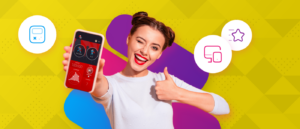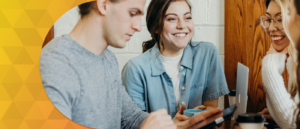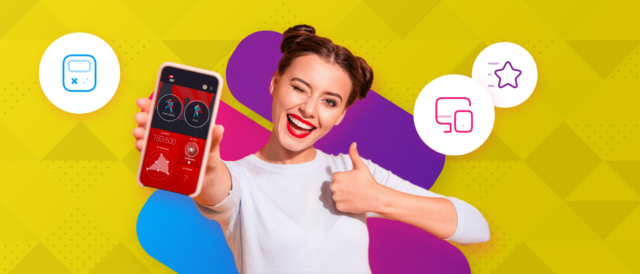Table of contents
ToggleAlbert Bandura’s social learning theory is a perspective that has left a deep impression on the field of psychology and education. This revolutionary approach to learning, which you might just have heard about on more than one occasion, explores how people acquire new knowledge and skills through observation and interaction with others.
In the business world, more and more organizations are turning to social learning in a bid to offer their employees new and exciting learning experiences. But to truly understand its value within professional development, we first need to recognise the key principles of the theory, how we can apply them to learning, and finally how they can be adapted to the digital age. Keep reading to discover it all!
Introduction to social learning theory
Social learning theory is based on the premise that people learn not only through direct experience, but also by observing others. Albert Bandura, a Canadian psychologist, developed this theory in the 1960s, enriching it with these key concepts: firstly, that in social settings, people learn best through observation and imitation; secondly, that a person’s mental state can affect this learning process; and lastly that even when something is learned in this environment, it does not mean that there will necessarily be a permanent change in behavior in the learner.
The key principles of Bandura’s theory
In his social learning theory Bandura states that, contrary to what was previously believed, it would in fact be very dangerous if a person learned only from their own experience. Instead, most humans learn to behave observationally through a process called modeling, and in his book Social Learning Theory, Bandura outlines his theory through four key principles:
Attention
Attention is essential for social learning. In order to learn from others, we must first place our attention on the details of the specific behavior we are observing. Bandura particularly emphasized the importance of selective attention throughout this process.
Retention
Retention is the ability to remember what we have observed. In order for social learning to be effective, we must be able to store the information we acquire through observation in our memory.
Reproduction
Once we have observed and retained information, we then need to reproduce the behavior or skill we have learned in the process. This involves putting our observations into practice in the real world.
Motivation
Motivation plays a crucial role in social learning. People are more willing to learn and put their observations into practice when they perceive that there is a benefit or reward associated with that learning.
The practical applications of social learning in education – with examples
Bandura’s social learning theory has undoubtedly had a great impact on psychology, but especially on education. This has led to the creation of a number of effective pedagogical practices, some of which we’ll take a closer look at below:
Behavioral modeling
In education, behavioral modeling encourages students to learn by observing their teachers and peers. Educators can take advantage of this principle to provide examples of appropriate behavior and demonstrate how to perform specific tasks.
For example, during a class the teacher gives a detailed demonstration of how to solve a particular problem. Students then observe and learn specific techniques from the teacher before trying it themselves.
Self-efficacy
Self-efficacy refers to a person’s belief in his or her ability to accomplish a certain task. Generally, educators can improve students’ self-esteem and confidence by providing them with successful and encouraging learning experiences.
Take, for example, a teacher working with a student who has had consistent difficulty in a specific area. The teacher presents activities or problems that are appropriate to the student’s level of understanding and that she knows she can solve successfully. When the student succeeds, the teacher then praises her achievement and so increases her self-efficacy.
Reinforcement and punishment
Bandura’s theory also applies to the use of reinforcement and punishment in the classroom. Educators can use positive reinforcement to encourage desired behavior and apply punishment, or negative reinforcement, fairly and constructively.
Examples include giving a positive grade to a student, or praising them in the classroom, for completing assignments in a timely manner. Negative reinforcement, on the other hand, could involve apportioning additional study time to students who need to improve their performance in a specific area.
Collaborative learning
Collaborative learning is based on the principle that students can learn from each other through social interaction. Bandura’s theory consistently emphasizes the importance of social relationships in the learning process.
Collaborative learning can be witnessed when students work together on a research project. As they collaborate, they observe and learn from each other’s unique contributions and perspectives.
Self-regulation
Self-regulation refers to a person’s ability to control and regulate their own behavior. Social learning theory places a high value on teaching students to self-regulate and set personal goals.
An educator might put this into practice by teaching their students planning and organizational strategies, so that they learn to manage their time, set goals, and monitor their own progress autonomously.
Problem solving modeling
Observing how others solve problems can be an effective way to learn new problem-solving strategies. Educators can use real-life examples and case studies to teach students how to approach complex situations.
For example, in the context of professional training, an instructor could guide students through the sales process step-by-step, showing them how to identify and solve any problems that may arise along the way.
Self-assessment and self-reflection
Students can use self-assessment and self-reflection techniques to measure their progress and learn from their own experiences. Bandura’s theory encourages self-reflection as an effective means of professional development.
A good example of this would involve students carrying out reviews of their own in-class exercises, using questionnaires to provide immediate feedback and identifying areas for improvement independently before submitting assessments.
Goal setting
Goal setting is an essential component of social learning. Students can accustom themselves to setting realistic and achievable goals by first observing how others do it, as well as receiving guidance from their educators.
In the classroom, a trainer might work individually with each student to help them establish their unique personal and professional goals. These goals would then guide each student onwards and define a specific purpose for learning.
Social learning in the digital age: The impact on professional development
When designing and carrying out business training programs, applying the principles of social learning theory can dramatically enhance the professional development of your employees. By integrating the four key elements of the theory into the learning process, companies can create and deliver engaging and effective learning experiences for employees.
Professionals continue to learn new skills and knowledge throughout their careers by observing colleagues, mentors, and experts in their fields. Today, it’s easier than ever to complement this process and implement social learning methodologies thanks to technological developments in training. But one development stands out as particularly helpful here – learning management systems.
An LMS is the ideal platform for building an online learning community, where companies can roll out their training programs, track and motivate employees through interactive content such as images, videos and simulations, and even manage group activities through chats, forums, virtual classrooms or webinars.
In fact, with a platform like isEazy LMS, designing online training programs that promote social learning in your employees is easier than ever. Our learning platform is much more than a plain old LMS, intuitively combining the best of an LXP with the powerful features of a next-generation LMS. Take advantage of its comprehensive features to organize your training content in an attractive, dynamic and flexible way – plus, manage your training, communication and corporate knowledge processes, all in one place. So what are you waiting for? Try it now and start enjoying the advantages of isEazy LMS!














